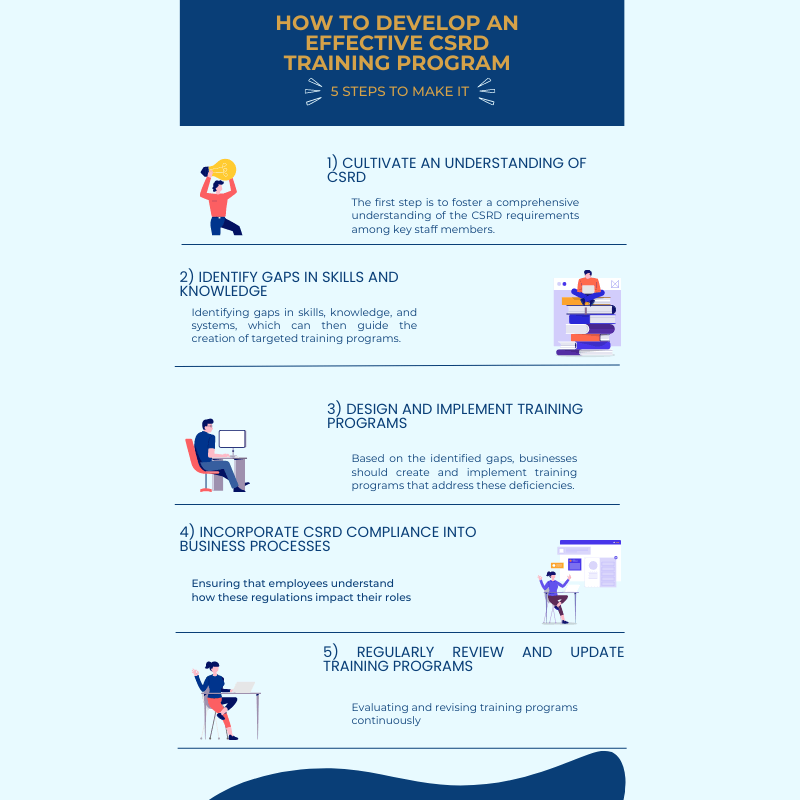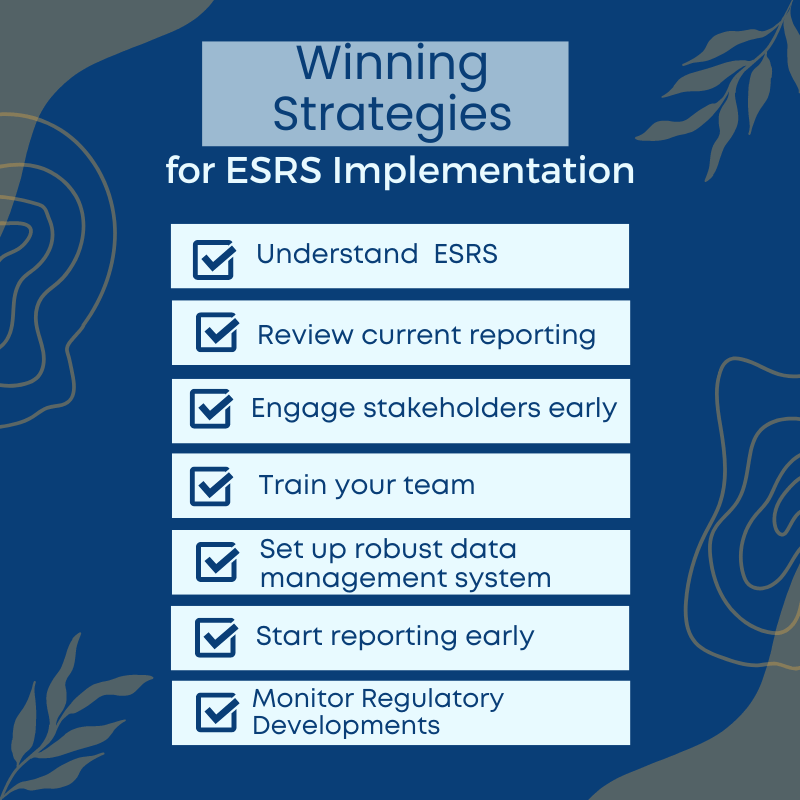In an era of growing corporate accountability, compliance with the Corporate Sustainability Reporting Directive (CSRD) is paramount. This EU directive defines the sustainability reporting requirements for companies operating in the EU, encouraging transparency, accountability, and comprehensive disclosure. To ensure adherence, strategic capacity building and effective training initiatives are vital. This post discusses how companies can equip their teams to navigate the subtleties of CSRD, assuring successful compliance and furthering their sustainability goals.
Understanding CSRD
Before diving into capacity building and training specifics, it’s crucial to understand CSRD. The CSRD is an EU Directive that extends the spectrum of non-financial reporting rules, mandating more corporations to report on various sustainability matters. It provides the legal framework for transparency in corporate sustainability reporting.
Why Capacity Building Matters for Compliance
CSRD compliance is a significant undertaking. It demands an in-depth comprehension of the regulations, the capacity to implement these guidelines into business practices, and robust systems for collecting, evaluating, and reporting sustainability data. Capacity building refers to the development of the requisite skills, knowledge, and systems within a corporation to meet these requirements.
Capacity building is vital for several reasons. Firstly, it assures compliance, helping corporations evade penalties and reputational damage related to non-compliance. Secondly, it allows businesses to spot and leverage opportunities stemming from sustainable practices, such as operational efficiencies and enhanced stakeholder relationships. Lastly, it ensures that corporations can effectively communicate their sustainability performance, thus boosting their corporate image and cultivating trust among stakeholders.
Constructing an Effective CSRD Training Program for Full Compliance

Creating capacity for full compliance relies heavily on effective CSRD training initiatives. Here are some key steps corporations can take:
1. Cultivate an Understanding of CSRD: The first step is to foster a comprehensive understanding of the CSRD requirements among key staff members. This can be achieved through studying the legal documents, attending workshops and seminars, taking e-course(s) and consulting with legal and sustainability professionals. An example is to take the Free CSRD Course by The CSRD Compass
2. Spot Gaps in Skills and Knowledge: After a firm understanding of the CSRD is established, businesses should assess their present capacity to meet these requirements. This entails identifying gaps in skills, knowledge, and systems, which can then guide the creation of targeted training programs.
3. Design and Implement Training Programs: Based on the identified gaps, businesses should create and implement training programs that address these deficiencies. This could include training on specific aspects of the CSRD, or more general training on sustainability management and strategy.
4. Incorporate CSRD Compliance into Business Processes: Training should aim to integrate CSRD compliance into everyday business operations. This means ensuring that employees understand how these regulations impact their roles and providing them with the skills and knowledge to incorporate compliance activities into their regular duties.
5. Regularly Review and Update Training Programs: Lastly, businesses should continuously evaluate and revise their training programs. As CSRD evolves, training initiatives should be updated to reflect these changes. Changes may stem from updating the directive or the publication of other related regulations such as the Corporate Sustainability Due Diligence Directive (CSDDD). Regular assessments can help businesses identify new capacity gaps and adjust their training programs accordingly.
Choosing an external training organization can be an excellent strategy for ensuring CSRD compliance. Their expertise can provide invaluable insights and alleviate the burden on your internal resources.
Choosing an External Training Provider
Here’s how to select an appropriate external training provider:
1. Identify Your Specific Needs: Have a clear understanding of your specific needs. What knowledge and skills gaps do you aim to fill? Which aspects of CSRD compliance do you find most challenging? An effective training provider should offer services that align with these needs.
2. Check their Expertise and Credentials: Choose training organizations with a solid track record in sustainability and a deep understanding of CSRD and related regulations and standards such as the European Sustainability Reporting Standards (ESRS), the EU Taxonomy, etc. They should have relevant experience and demonstrate their expertise through initial engagements with your team, e.g. an introduction call.
3. Consider their Approach to adult learning: Different training organizations have varying teaching approaches. Depending on your needs and preferences, you might prefer one approach over the other. The best training providers typically provide a balance of both, offering learners a solid theoretical foundation and opportunities to apply what they’ve learned in practical situations. Training should be tailored to your organization’s context and be interactive to maximize the learning experience of the participants.
4. Evaluate their Resources and Tools: Good training providers should offer a wide range of resources and tools to support learning. This might include things like interactive learning materials, practical examples, case studies and ongoing support and feedback. The availability of these resources can significantly enhance the effectiveness of the training.
5. Assess Their Ability to Customize Training: The ability to customize training to meet your specific needs is a valuable feature to look for in a training provider. They should be willing and able to adjust their programs to align with your business goals, culture, and specific CSRD compliance challenges.
6. Cost and Value for Money: Finally, consider the cost of the training and whether it offers good value for money. The most expensive option isn’t necessarily the best. Neither are the cheapest ones! Instead, look for a provider that offers high-quality training at a price that fits your budget.
E-learning or In-person Training?
Deciding between e-learning and in-person training can significantly impact the effectiveness of your CSRD compliance training. Here’s how to make this choice:
1. Consider Your Learning Objectives: Reflect on your learning objectives. Do you need to disseminate information widely across a large team, or is the focus more on developing in-depth skills for a smaller group? E-learning can be an effective way to share information broadly, while in-person training often allows for more intensive skill-building.
2. Assess Your Team’s Learning Styles: People learn in different ways. Some people thrive in a self-paced, online environment, while others benefit from the social interaction and immediate feedback that comes with in-person training. Consider conducting a survey to understand your team’s preferred learning styles and take these preferences into account when deciding on the training format. Sometimes, providing both is the best option!
3. Evaluate Resource Availability: Resource availability is another crucial factor. E-learning can often be more cost-effective, as it requires less logistical coordination and can typically be scaled more easily. On the other hand, in-person training can require a significant investment in terms of time, money, and logistical planning.
4. Flexibility and Convenience: E-learning provides flexibility, allowing employees to learn at their own pace and on their own schedule. This can be especially advantageous for businesses with remote or distributed teams. In-person training, though less flexible, provides a structured learning environment that some learners may prefer.
5. The Nature of the Material: Consider the complexity of the material being taught. If the training content is highly complex or requires a significant level of hands-on practice, in-person training might be the best option. For more straightforward, informational content, e-learning can be just as effective.
6. Opportunities for Interaction: If a high level of interaction is desirable, in-person training might be the best fit. While some e-learning platforms do offer interactive features, the level of interaction is typically higher in in-person settings.
7. Evaluation and Feedback: Both e-learning and in-person training can incorporate mechanisms for evaluation and feedback. However, in-person training often allows for more immediate and personalized feedback. If regular, individualized feedback is a priority, in-person training might be more suitable.
In conclusion, the choice between e-learning and in-person training will depend on various factors, including your specific learning objectives, team preferences, available resources, and the nature of the training content. By considering these factors carefully, you can choose a training format that optimizes learning outcomes and successfully builds your team’s capacity for CSRD compliance.
A combination of both e-learning and in-person training?
The hybrid approach, which combines e-learning and in-person training, provides an effective and efficient way to build capacity for CSRD compliance. This two-pronged strategy allows you to capitalize on the benefits of both training styles, fostering a comprehensive understanding of CSRD, and developing the skills needed to apply this knowledge in practice.
Foundations Through E-Learning
E-learning provides a great starting point for CSRD training. The initial phase can effectively cover the broad strokes of the CSRD directive, its implications for businesses, and general requirements for compliance. The self-paced nature of e-learning ensures team members can take the time they need to digest this foundational knowledge. Interactive modules and online quizzes can reinforce these principles, ensuring a solid grounding.
Deep Dive with Tailored In-Person Training
Once the team has a robust understanding of the basics, in-person training sessions can be utilized for a more targeted, in-depth exploration of specific aspects of CSRD. These sessions can focus on the most challenging areas identified through e-learning assessments, providing a platform for nuanced discussions, immediate feedback, and hands-on exercises.
Tailored training also aligns with your company’s specific needs, culture, and operational nuances. This is critical in ensuring that the knowledge and skills gained through training translate into effective, compliant practices within your organization.
The Power of Combination
Adopting a hybrid approach gives you the best of both worlds. E-learning lays the groundwork, ensuring everyone starts with a strong understanding of the basics, while in-person training builds on this foundation, delving deeper into areas that require further clarity or practical application. This combination enhances learning outcomes and embeds CSRD compliance deeply within your team.
Check out CSRD Training offers by The CSRD Compass
Have you ever stared at a stack of regulatory documents and standards, perplexed by the cryptic language of the CSRD and ESRS? Break free from the jargon jungle and gain command over the art of compliance! We’ve crafted the ultimate guide to mastering these crucial regulations – no legal dictionaries required.
Welcome to our exclusive e-courses on the Corporate Sustainability Reporting Directive and the European Sustainability Reporting Standards. Navigate the intricate labyrinth of regulations and standards with ease, as we unravel their complexities in a user-friendly, engaging manner. Our interactive modules, expert-led content and real-world case studies simplify compliance, turning it from a chore into a strategic asset.
But, we don’t stop at digital learning. Experience a tailored training journey, designed to resonate with your organization’s unique context. Every business has a unique story to tell, and our in-person training helps you weave sustainability into your narrative, aligned with CSRD and ESRS. We don’t believe in one-size-fits-all solutions; we create trainings that fit like a glove, making compliance effective, effortless, and empowering.
Why remain on the sidelines when you can lead the sustainability race? Join our e-courses today and unlock the door to a world where compliance is not just about ticking boxes, but about making a difference. Contact us now to schedule your bespoke in-person training, tailored to your organization’s unique needs. With us, compliance becomes an adventure, not an ordeal. Step into a future where your organization shines as a beacon of sustainability. Buckle up; your journey to mastery begins here.


